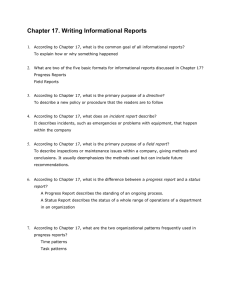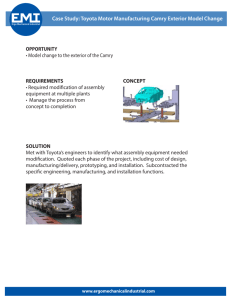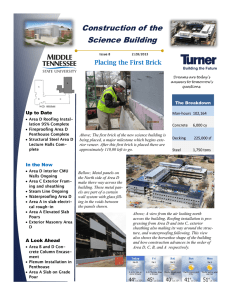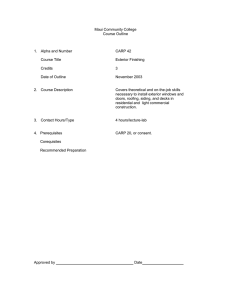14.0 exterior finishes 14.1 general exterior finishes
advertisement
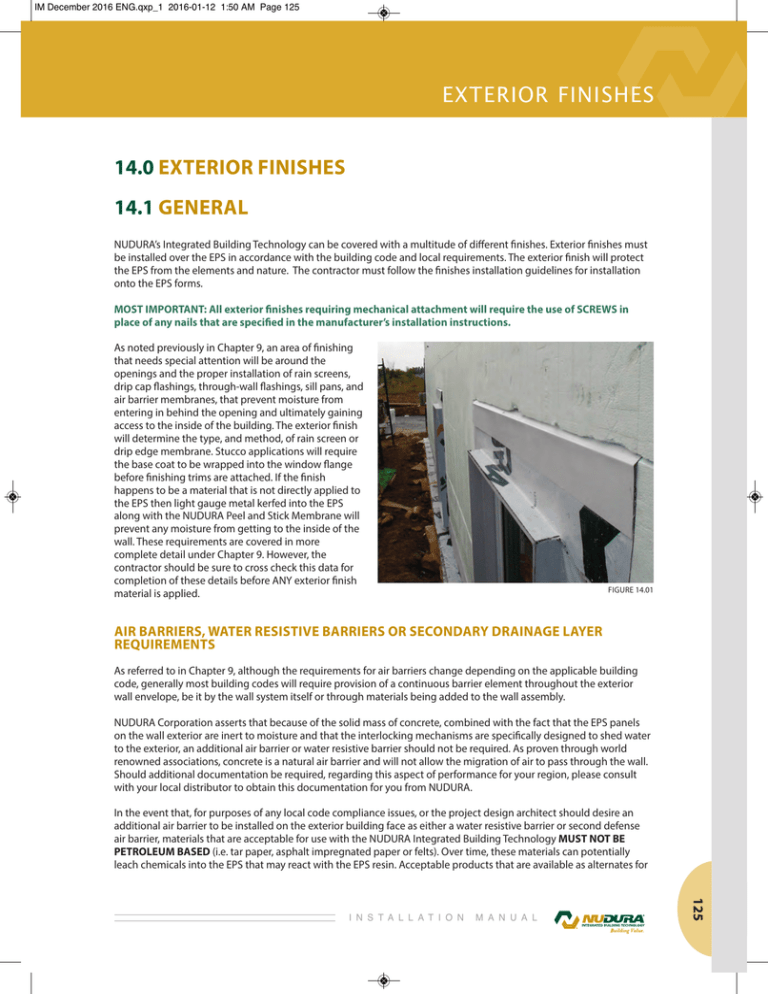
IM December 2016 ENG.qxp_1 2016-01-12 1:50 AM Page 125 EXTERIOR FINISHES 14.0 EXTERIOR FINISHES 14.1 GENERAL NUDURA’s Integrated Building Technology can be covered with a multitude of different finishes. Exterior finishes must be installed over the EPS in accordance with the building code and local requirements. The exterior finish will protect the EPS from the elements and nature. The contractor must follow the finishes installation guidelines for installation onto the EPS forms. MOST IMPORTANT: All exterior finishes requiring mechanical attachment will require the use of SCREWS in place of any nails that are specified in the manufacturer’s installation instructions. As noted previously in Chapter 9, an area of finishing that needs special attention will be around the openings and the proper installation of rain screens, drip cap flashings, through-wall flashings, sill pans, and air barrier membranes, that prevent moisture from entering in behind the opening and ultimately gaining access to the inside of the building. The exterior finish will determine the type, and method, of rain screen or drip edge membrane. Stucco applications will require the base coat to be wrapped into the window flange before finishing trims are attached. If the finish happens to be a material that is not directly applied to the EPS then light gauge metal kerfed into the EPS along with the NUDURA Peel and Stick Membrane will prevent any moisture from getting to the inside of the wall. These requirements are covered in more complete detail under Chapter 9. However, the contractor should be sure to cross check this data for completion of these details before ANY exterior finish material is applied. FIGURE 14.01 AIR BARRIERS, WATER RESISTIVE BARRIERS OR SECONDARY DRAINAGE LAYER REQUIREMENTS As referred to in Chapter 9, although the requirements for air barriers change depending on the applicable building code, generally most building codes will require provision of a continuous barrier element throughout the exterior wall envelope, be it by the wall system itself or through materials being added to the wall assembly. NUDURA Corporation asserts that because of the solid mass of concrete, combined with the fact that the EPS panels on the wall exterior are inert to moisture and that the interlocking mechanisms are specifically designed to shed water to the exterior, an additional air barrier or water resistive barrier should not be required. As proven through world renowned associations, concrete is a natural air barrier and will not allow the migration of air to pass through the wall. Should additional documentation be required, regarding this aspect of performance for your region, please consult with your local distributor to obtain this documentation for you from NUDURA. In the event that, for purposes of any local code compliance issues, or the project design architect should desire an additional air barrier to be installed on the exterior building face as either a water resistive barrier or second defense air barrier, materials that are acceptable for use with the NUDURA Integrated Building Technology MUST NOT BE PETROLEUM BASED (i.e. tar paper, asphalt impregnated paper or felts). Over time, these materials can potentially leach chemicals into the EPS that may react with the EPS resin. Acceptable products that are available as alternates for M A N U A L 125 I N S T A L L A T I O N IM December 2016 ENG.qxp_1 2016-01-12 1:50 AM Page 126 EXTERIOR FINISHES this purpose include typical flash-spun polyethylene fiber based breathable air barrier materials such as TYVEK® or TYPAR®. These materials are tested and approved air barriers designed for use where needed within the building envelope. As stated above, though NUDURA asserts that they are NOT necessary in the vast majority of installation scenarios, local Codes or the designers themselves may require these materials to be installed. The contractor should ascertain their requirement for a particular project PRIOR to bidding the job. 14.2 FINISH MATERIALS BRICk Masonry brick or stone can be installed as a finished product onto the EPS material. A corbelled brick ledge form is required for support of the brick or stone. As stated in Chapter 6, section 6.9, the corbelled ledge can support the equivalent weight of 27’ (8.2 m) of standard weight brick. Should a heavier brick or stone be specified for the exterior finish, the overall height will decrease to match the weight difference from the heavier materials. NOTE: It’s important to remember that brick veneer will still require a through-wall flashing to be installed between the first course and the supporting ledge. Just as the drip cap flashings discussed in Chapter 9 must be kerf cut upward at a 45º angle into the foam, a minimum distance of 1” (25 mm) the same is true for brick veneer through-wall flashings installed at the top of a brick ledge or for a taper top form being used to support brick veneer. The flashing also needs to be sealed at all joints exactly the same as in conventional construction to ensure any bulk water that may get behind the cavity never penetrates into the ledge or tapered top form (see Figure 14.02). FIGURE 14.02 In addition, brick ties will need to be connected to the fastening strips using screws at the recommended spacing dictated by code (usually 16” x 16” or 16” x 24” (400 mm x 400 mm or 400 mm x 600 mm) spacing. Should the brick extend over openings, a steel lintel will be required as per typical construction methods and sized as per prescriptive code requirements or as specified by the designer. WOOD SIDING Wood siding can be installed onto NUDURA’s Integrated Building Technology either vertically or horizontally. The installation instructions of the siding manufacturer must be followed to ensure the warranty is covered. For example, if the building has been specified to have prefinished wood siding applied to the wall and the manufacturer’s installation instructions require an air barrier and strapping to be applied to the wall in order to meet their warranty, then the contractor must follow these instructions. Even though NUDURA’s Integrated Building FIGURE 14.03 Technology does not require an additional air barrier due to the solid mass of the concrete wall and EPS foam, the wood siding manufacturers’ procedures override NUDURA’s recommendations. Vertical siding will require additional strapping attached, using screws, to the fastening strips of the forms. 126 I N S T A L L A T I O N M A N U A L IM December 2016 ENG.qxp_1 2016-01-12 1:50 AM Page 127 EXTERIOR FINISHES CEMENT BOARD SIDING Unlike wood siding which requires strapping, Cement board siding can be directly installed onto NUDURA’s walls. This provides the continuous support that cement board sidings typically require. However, to be certain of specific requirements, (i.e. changing requirements for drainage, consult with the manufacturers’ latest installation instructions that need to be followed for warranty purposes). Some manufacturers will recommend the siding to be nailed to the wall, however remember that NUDURA does require that the siding be screwed in place, as nails will not provide adequate holding power and also will not penetrate through the polypropylene fastening strips. An alternative cement board siding screw is recommended for this purpose which is typically blind fastened at regular intervals along the top edge of each siding component which is then covered by the lapping siding component above. Documentation is available from NUDURA on this method through your local distributor. STUCCO FIGURE 14.04 Stucco is a popular finish on NUDURA’s Integrated Building Technology as it can be directly applied to the EPS, with no additional foam attached to the wall. As with finishes already discussed, the contractor will need to follow the stucco manufacturer’s installation instructions to ensure proper techniques are completed. There are a few different types of stucco materials still being used in the construction industry, and all can be applied to NUDURA’s Integrated Building Technology. EIFS (Exterior Insulation Finishing System) is probably the most popular type of acrylic stucco coating available and is adapted specifically for application to Insulated Concrete Form Systems under the term DAEFS (Direct Applied Exterior Finishing Systems). This system is a 2 part product FIGURE 14.05 that has an acrylic makeup that allows the basecoat to bond to the EPS without a mechanically fastened wire mesh – and provides excellent flexibility for high temperature transition regions. A fiber mesh is still required but is embedded as the base coat is applied to the wall. One thing worth mentioning is that the stucco installer needs to properly rasp the EPS foam of the wall system first, to give the base coat a rough surface texture to bond properly to. Traditional hard coat stuccos can also be applied to the NUDURA wall using the manufacturer’s installation instructions. As stated with respect to other finishes, the wire mesh (or expanded metal lath) will need to be mechanically connected to the fastening strips using screws and NOT nails. As with acrylic based stuccos, the surface of the EPS usually needs to be rasped to ensure a strong bond of the base coat to the foam. Hard coat stuccos can vary in application method (either 2 coat or 3 coat systems – (i.e. Scratch, Brown and Finish coatings). Instead of rasping the EPS foam surface -in some instances, the stucco installer MAY require a drainage medium to be installed behind the stucco. Consult with your stucco installer FIRST to determine what may be required. As stated earlier in this Section, remember that tar or asphalt based building paper is not suitable for application to NUDURA. Another type of stucco is a 3 part stucco system. This finish requires the installation of a cement board onto the wall surface, a wire mesh, and finally the cementitious coat applied. The cement board will be required to be connected to the fastening strips using screws. An air barrier may be required for warranty purposes with this type of finish. M A N U A L 127 I N S T A L L A T I O N IM December 2016 ENG.qxp_1 2016-01-12 1:50 AM Page 128 EXTERIOR FINISHES STEEL SIDING Although steel siding is not very common on residential buildings, garages built on residential properties can be clad with a vertical or horizontal steel siding. Depending upon the manufacturer’s installation instructions, strapping might be required to be connected to the wall before the steel siding is installed. If the siding is to be installed vertically then strapping is required, and needs to be attached to the fastening strips using FIGURE 14.06 screws. Building papers might be required as per the siding manufacturer installation methods but, as noted earlier, this needs to be a material that will not affect the EPS when in contact. The siding must be attached to the NUDURA wall system using the manufacturer’s approved screw. If available, a self tapping/self drilling screw will work best for direct attachment to the fastening strips. VINYL SIDING Like steel sidings and wood sidings, vinyl siding products must be installed as per the manufacturer’s installation methods. Should the siding be directly installed into the NUDURA wall system, NUDURA recommends that the fasteners be screws, not nails. Additionally, if the siding manufacturer requires a building paper to be installed on the wall for warranty, then the paper needs to be a product that will not react with the EPS insulation. Also, should the installation techniques require that the building be strapped, these recommendations must be carried out as the siding manufacturers warranty might require it. NUDURA DOES NOT recommend pneumatic nailing for exterior finishes as the nails are much larger and potentially could damage the fastening strips. FIGURE 14.07 128 I N S T A L L A T I O N M A N U A L IM December 2016 ENG.qxp_1 2016-01-12 1:50 AM Page 129 EXTERIOR FINISHES THIN VENEER MANUFACTURED BRICk AND STONE FINISHES As with all finishes, NUDURA Corporation always recommends that the product specified as a finish material for the building should be installed as per the manufacturer’s installation instructions. Thin veneer stone and brick products by manufacturers such as Cultured Stone®, Kettle Valley®, or Natural Stone Veneers®, are not any different and will need to be installed as per the recommendations of each manufacturer. Most manufacturers have a set of installation procedures for their products, but NUDURA suggests the following procedures should be adopted for specifically adapting this process to the NUDURA form system: • Install layer(s) of weather resistant barrier, per stone manufacturer’s installation instructions, directly over exterior surface of the NUDURA form system • Install manufacturer specified (re. gauge and style) wire mesh or expanded metal lath through EPS insulation into NUDURA fastening strips using #10 dia. X 2” (50 mm) long coarse thread pan head, self tapping thread screws complete with ½” (12.7 mm) washers • Apply screws in an 8” (203 mm)o/c horizontal x by 12” (300 mm) o/c vertical grid pattern • Apply manufacturer’s recommended scratch coat over wire mesh to bond to weather barrier below the mesh • Allow scratch coat to cure as per manufacturer’s specifications • Apply final mortar setting bed coat to scratch coat using materials and methods as outlined in the stone veneer manufacturer’s installation instructions and, again, allow material to cure to specs • Apply stone as per manufacturer’s specifications to bond to mortar bed coat and final detail mortar joints once dry The above noted methodology should be reviewed with the selected stone manufacturers’ technical advisors to assure compliance to their latest endorsed methods of application over EPS (Expanded Polystyrene) foam surfaces OR to Insulated Concrete Form Systems, specifically NUDURA Integrated Building Technology. OTHER MANUFACTURED FINISH OPTIONS Though not common to all industry segments, other finishes may arise that are not specifically covered here. These may include novel brick or siding systems (i.e. Novabrik®, Centria® Finish Panels, Nichiha® Fibercement Panels etc.) Each has their own anchorage system that can be adapted to NUDURA with the right instruction and technical information. Should specialty systems arise, before installation starts, consult with your local distributor for NUDURA’s specific assistance in working with the manufacturer for specifying the required attachment for each system. In conclusion –the techniques represented here are intended for general installation guidance only. As with any exterior finishing material, NUDURA Corporation will always refer the contractor back to the finishes manufacturer’s installation requirements to have them review and amend as required for their specific purposes, the procedures suggested here. NUDURA will not be held responsible for any finish material that is incorrectly installed onto its products. If an exterior finish should become defective before the expected life cycle of the product, NUDURA Corporation will not be held liable for any replacement of such material. M A N U A L 129 I N S T A L L A T I O N

